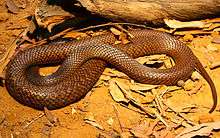Pseudonaja nuchalis
Pseudonaja nuchalis , commonly known as the western brown snake[1] or gwardar, is a species of very fast, highly venomous elapid snake native to Australia. Its colour and pattern are rather variable, depending largely on its location.[1] Some experts assert that the western brown's wide variation in appearance and extensive distribution mean that the western brown species, in fact, covers multiple related, but separate species[2] with three derivative species now officially recognised, P. nuchalis, P. aspidorhyncha, and P. mengdeni.[3]
| Pseudonaja nuchalis | |
|---|---|
 | |
| A western brown snake at the Australia Zoo | |
| Scientific classification | |
| Kingdom: | Animalia |
| Phylum: | Chordata |
| Class: | Reptilia |
| Order: | Squamata |
| Suborder: | Serpentes |
| Family: | Elapidae |
| Genus: | Pseudonaja |
| Species: | P. nuchalis |
| Binomial name | |
| Pseudonaja nuchalis Günther, 1858 | |
The name gwardar is a word meaning "go the long way around" in an Aboriginal language . This may be regarded as advice for people who come across the species in the wild: that is, while P. nuchalis is generally cautious, shy, and inclined to retreat rather than attack, it will defend itself if cornered.
Description
The western brown snake grows up to 1.8 m (5 ft 10.87 in) in total length (including tail). Its back can feature shades of orange-brown with flecks and bands, or appear plain. Its belly is cream to orange with pink blotches. Some individuals have jet black heads (this can cause it to be confused with the black-headed python),[4] while others feature a black 'V' shape on the back of their neck, below their head.[5]
Distribution and habitat
The western brown has a wide distribution and is found across most of the Australian continent, including all of the Northern Territory, as well as most of Queensland, Western Australia, and some of Victoria.[6]
The western brown is a ground-dwelling snake that prefers drier habitats, but is also found in coastal eucalypt forests, woodlands, and grasslands.[4] Although the western brown is not an arboreal species, not uncommon it climbs small shrubs or trees. It also hides in crevices and under rocks, and in urban areas can be found under rubbish or tin piles.
Lifespan and reproduction
Little is known about the western brown's lifespan. Mating season is roughly from September to November and the female usually produces around 11-14 eggs,[4] but may produce up to 38.[6]
Venom and symptoms
Although the western brown snake's venom is not the most toxic in the brown snake genus, its average delivery contains a relatively high quantity of venom, thus the western brown snake has high potential to deliver a deadly bite.[6] Its venom contains neurotoxins, nephrotoxins, and a procoagulant, although humans are not usually affected by the neurotoxins.[1] The bite is usually painless and difficult to see due to their small fangs. Human symptoms of a western brown snake bite are headache, nausea/vomiting, abdominal pain, severe coagulopathy, and sometimes kidney damage.[8] In dogs and cats, paralysis is also likely to occur.
Behaviour
The western brown snake is known to be very aggressive when disturbed or threatened, but like most snakes, usually prefers to retreat from danger.[9] It may develop nocturnal habits during the warmer months, but is otherwise active during the day and enjoys sunlight.[4] The snake has also been known to practise cannibalism, although this is not common.[10] Western brown snakes kill their prey with a combination of venom and constriction.[5]
References
- Venom Supplies Pty Ltd. "Brown Snakes". Retrieved 2009-03-24.
- Australian Nature Live. "The Brown Snake Complex" (PDF). Retrieved 2009-03-24.
- Beatson, Cecilie. "Animal Species: Western Brown Snakes (nuchalis-complex)". Australian Museum. Retrieved 1 December 2013.
- Queensland Museum. "Queensland Museum - Snakes - Species Detail". Retrieved 2011-09-27.
- James Cook University. "Pseudonaja nuchalis" (PDF). Archived from the original (PDF) on 2012-02-14. Retrieved 2009-03-25.
- "Western Brown". Pilbara Pythons. Archived from the original on 2009-04-20. Retrieved 2009-03-24.
- Swan M, Watharow S. "Snakes Sample.pdf" (PDF). Snakes, Lizards and Frogs of the Victorian Mallee (sample). Retrieved 2009-03-25.
- "CSL Antivenom Handbook - Brown Snake Antivenom". Toxicology Department, Women's & Children's Hospital, Adelaide, Australia. Retrieved 2009-03-24.
- Wallis G. "Don't chase Brown Snakes (Pseudonaja nuchalis)". YouTube. Retrieved 2010-09-09.
- Cavanagh, Rebekah. "Northern Territory News". Northern Territory News. Retrieved 2009-03-24.
Further reading
- Boulenger GA (1896). Catalogue of the Snakes in the British Museum (Natural History). Volume III., Containing the Colubridæ (Opisthoglyphæ and Proteroglyphæ), ... London: Trustees of the British Museum (Natural History). (Taylor and Francis, printers). xiv + 727 pp. + Plates I-XXV. (Diemenia nuchalis, pp. 326–327).
- Günther A (1858). Catalogue of the Colubrine Snakes in the Collection of the British Museum. London: Trustees of the British Museum. (Taylor and Francis, printers). xvi+ 281 pp. (Pseudonaja nuchalis, new species, pp. 227–228).